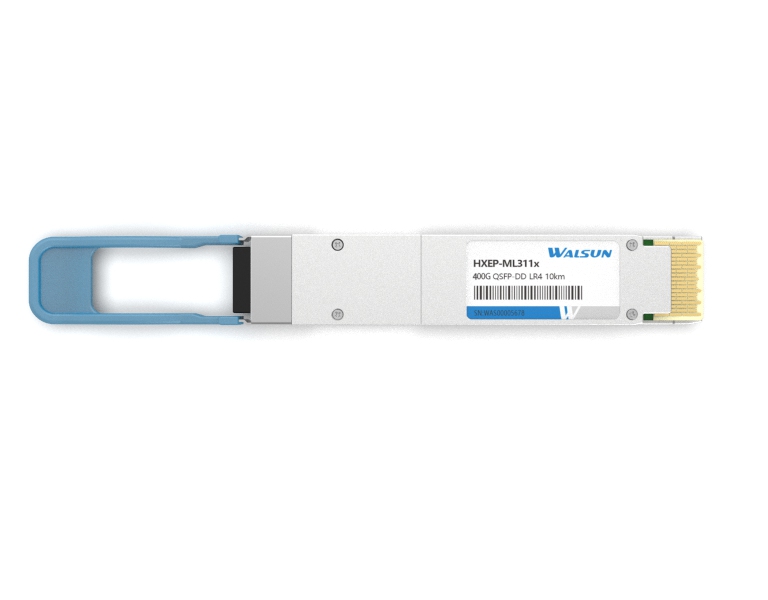

 Knowledge Base +
Knowledge Base +  2023.11.28
2023.11.28Yes, power efficiency is an important consideration in networking, especially when deploying high-speed transceivers like 400GBASE-FR4 (400 Gigabit Ethernet Four-Wavelength Short-Range). Here are some considerations for power efficiency with 400GBASE-FR4 transceivers:
Power Consumption:
Evaluate the power consumption of 400GBASE-FR4 transceivers. Lower power consumption is generally favorable, especially in energy-conscious data center environments. Understanding the power requirements of the transceivers helps in designing a more efficient and sustainable network.
Power per Bit:
Consider the power efficiency on a per-bit basis. Higher data rates, such as those supported by 400GBASE-FR4, can lead to increased power consumption. Analyzing the power efficiency per transmitted bit provides insights into how effectively the transceivers utilize power for data transmission.
Energy-Efficient Components:
Look for transceivers that incorporate energy-efficient components and technologies. Advances in semiconductor technology can contribute to reduced power consumption without compromising performance.
Dynamic Power Management:
Check if the 400GBASE-FR4 transceivers support dynamic power management features. Dynamic power management allows the transceivers to adjust power levels based on the actual data transmission requirements. This can result in power savings during periods of lower network activity.
Idle Power Consumption:
Assess the idle power consumption of the transceivers. Even when not actively transmitting data, transceivers may consume a certain amount of power. Lower idle power consumption is advantageous for overall energy efficiency, especially in scenarios where network traffic fluctuates.
Regulatory Compliance:
Ensure that the 400GBASE-FR4 transceivers comply with relevant regulatory standards for power efficiency. Compliance with industry standards demonstrates that the transceivers meet established benchmarks for energy efficiency and environmental impact.
Cooling Requirements:
Consider the impact of power consumption on cooling requirements. Higher power consumption may necessitate more robust cooling solutions, contributing to additional energy consumption. Optimal power efficiency involves a balance between power consumption and cooling efficiency.
Temperature Operating Range:
Check the specified temperature operating range of the transceivers. Efficient thermal management is essential for maintaining reliable performance, and an optimized temperature range can contribute to lower power consumption.
Efficient Networking Architecture:
Consider the overall network architecture for its power efficiency. Efficient design and deployment of networking equipment, including 400GBASE-FR4 transceivers, can contribute to a more energy-efficient data center or network.
Power Budget Planning:
Plan the power budget for the entire network infrastructure, considering the cumulative power consumption of all components, including transceivers. This ensures that the overall network operates within acceptable power constraints.
By taking these considerations into account, network administrators can make informed decisions to optimize power efficiency when deploying 400GBASE-FR4 transceivers in their networking environments. This is particularly important as data centers and networks strive to balance performance requirements with energy-conscious practices.
4x100Gbps QSFP-DD: This type of QSFP transceiver can transmit and receive data at speeds of up to 100 Gbps. It is typically used in data centers and for very high-speed data links. The 4x100Gbps QSFP-DD transceiver uses four 100Gbps lanes to transmit and receive data. This allows for a total throughput of 400 Gbps. The 4x100Gbps QSFP-DD transceiver is typically used in data centers, where the need for very high-speed data transfer is becoming increasingly important. It is also used for very long-distance data links, such as those between data centers in different continents.

What is a QSFP Port?
QSFP, or quad small form factor pluggable, is another type of compact, hot-swappable transceiver. It supports Ethernet, Fibre Channel, InfiniBand and SONET/SDH standards with different data rate options. QSFP modules are commonly available in several different types: 4x1Gbps QSFP, 4x10Gbps QSFP+, 4x28Gbps QSFP28.
QSFP+ and QSFP28 are the most recent versions, which support numerous 40Gbps and 100Gbps applications. Both QSFP+ and QSFP28 modules integrate 4 transmit and 4 receiver channels. While QSFP+ supports 4x10Gbps or 1x40Gbps, QSFP28 can do 4x25Gbps, 2x50Gbps or 1x100Gbps, depending on the transceiver used. The specifications for QSFP are based on SFF-8436.
How to Choose SFP Transceivers?
In addition to SFP vs SFP+ vs QSFP, you’ll also need to consider the application. SFP transceivers are available in different types depending on what they will be used for, for example single-mode vs multimode SFP. Single-mode SFP transceivers work with single-mode fibre, whereas multimode SFPs are compatible with multimode fibre. Additionally, there are long-reach WDM SFP transceivers for multiplexing, simplex SFPs for single fibre applications, video SFP transceivers for transmission of high-definition video, and PON SFP transceivers for fibre-based access networks. SFPs are available in commercial and extended operating temperature ranges, with or without extended diagnostics capabilities.
Subscribe to the newsletter
for all the latest updates.
2-5# Building, Tongfuyu Industrial Zone, Aiqun Road, Shiyan Street, Baoan District, Shenzhen. China
